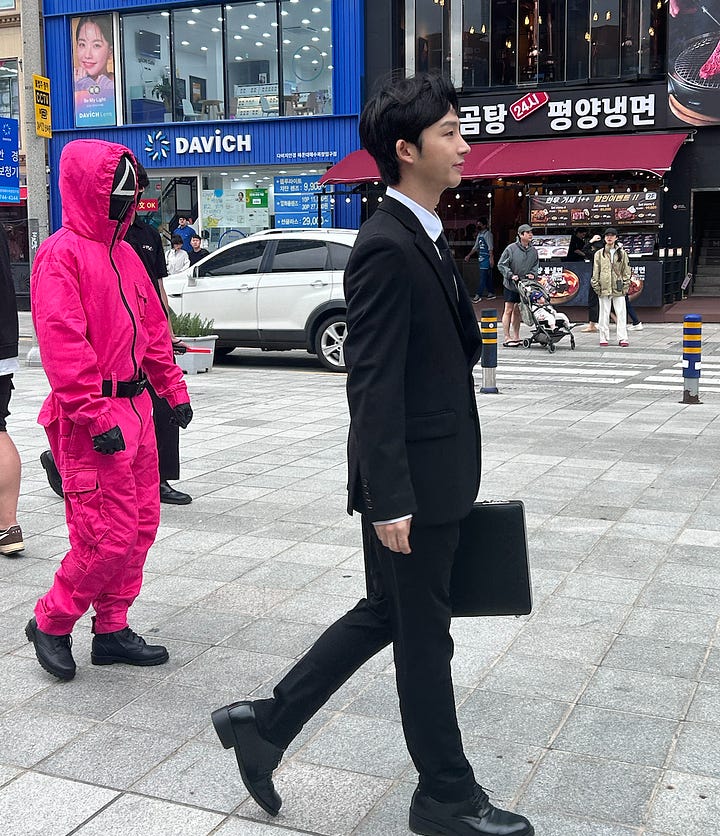✨ The Rise of the K-Economy: How Culture became South Korea’s Secret Weapon
For the first time in history, South Korea’s per capita GDP has surpassed Japan’s. Which is wild when you think about it. But what’s even more interesting is how they did it.
Flashback to July 27th, 1953, North and South Korea sign an armistice, unofficially ending the war. The country was in ruins, and South Korea was one of the poorest places on Earth, with a GDP of just AU$150 per capita. Less than Kenya, Ethiopia, and Yemen.
Fast forward 70 years, and South Korea has completely reinvented itself. It went from factories and manufacturing giants like Hyundai and Samsung to being a full-blown cultural powerhouse. K-pop, K-dramas, K-beauty, these aren’t just trends; they’re billion-dollar industries. Now, South Korea is the 14th largest economy in the world, and has taken control of one very iconic letter: K.
It’s 1953. The Korean War stands still. The country is hurting, But South Koreans? They get to work.
This is where the Hyundai and Samsung era begins.
Hyundai: Built Different
You have to talk about Chung Ju-yung if you’re talking about South Korea’s rise. He’s the founder of Hyundai and maybe one of the most legendary entrepreneurs you’ve never heard of.
Chung was born into a poor farming family in what’s now North Korea. He tried to escape his life of poverty not once, not twice, but three times before he finally made it out for good at the age of 18. He hustled. He did every job under the sun: dock worker, bookkeeper, manual labourer, even opened a rice shop (which was shut down by the Japanese occupation). But he didn’t quit. In 1947, he founded Hyundai Engineering & Construction, and from there, he built an empire that changed the face of South Korea, one highway, one shipyard, and one car at a time.
One of the most interesting things he achieved was crossing an uncrossable border! He never forgot his roots. In 1998, he was the first civilian to be allowed to visit North Korea, the land he’d fled decades earlier, leading a convoy of 500 cows in 50 Hyundai trucks as a peace offering.
Samsung and the Chip Game
While Hyundai was out building roads and cars, Samsung was in the lab cooking up tech that would power the future. Fast forward to today, and Samsung and SK Hynix control over 60% of the world’s memory chip market. Many of the devices we use every day would not function without South Korean semiconductors.
But none of that happened by accident. South Korea has treated research and development like a national sport. They invest around 4.8% of their GDP into R&D, one of the highest rates globally. (Australia clocks in at 1.8%, New Zealand, even less..)
And it’s not just money, it’s mentality. Innovation isn’t optional in Korea. It’s baked into everything. From robotics to biotech to semiconductors, they’ve built an entire economy around staying well ahead of the curve.
All this laid the foundation for the next generation of Korean powerhouses, the scrappy, culture-savvy, tech-fuelled startups.
K-Startup Nation: Why South Korea is a Founder’s Playground
Once known only for big conglomerates like Hyundai and Samsung, South Korea is now swimming in unicorns. In 2023 alone, South Korea had 23 unicorns (startups valued at over $1 billion). And they’re not just hanging around Seoul, they’re building apps, raising millions and going global.
Toss, Baemin, Coupang: the cool kids of Korean Tech
Let’s start with Toss, South Korea’s top fintech app. It's kind of like if Paypal, Robinhood, and your online bank had a super clean, minimalist baby. Toss is run by a former dentist named Lee Seung-gun, yes, a dentist, who turned his side project into a $7.4 billion company.
Then there is the big dog, Coupang. They offer next-morning delivery on basically everything and have warehouses all over the country. When they IPO’d in New York, they raised a casual $4.6 billion. Their founder Bom Kim dropped out of Harvard and built Coupang from scratch. It now employs more than 50,000 people and was valued at around $60 billion on debut.
Finally we’ve got Brian Kim, the guy behind Kakao, Korea’s biggest messaging app, payment platform, ride-share company, music service, and more. If you’re in Korea, you can’t live without Kakao. It’s WhatsApp + Uber + Spotify + your bank + a bunch of cute cartoon characters... all in one.
Kim’s story? Self-made. He grew up poor, taught himself to code, and built KakaoTalk in 2010. Now, 90% of South Koreans use his app. He turned a simple chat platform into a $60+ billion tech empire.
The South Korean government gets it when it comes to startups. They’ve launched a program called Startup Korea, and they’re not playing around.
We’re talking:
Co-working campuses called Space-K
Huge funding programs like TIPS, which matches private capital with government grants and has helped over 3,000 startups
Just this week the Government has announced USD $27M in K-Beauty startups 💅🏻
Visa programs to attract international founders
A massive KRW 2 trillion (USD 1.5B) fund focused on AI, deep tech, and global expansion
And they’re actively reforming outdated regulations so new ideas don’t get shut down by old rules.
K-Pop and K-Drama: Music That Prints Money
BTS: The GDP Boy Band
At their peak, BTS contributed around $5 billion to South Korea’s economy. That’s the equivalent of hosting the Olympics every year. They’ve spoken at the UN, been invited to the White House, and broken the internet more times than I can count. In LA, one of their concert runs brought in $33 million in four nights. A Seoul think-tank estimated that BTS brought in 7.6% of foreign tourists between 2014 and 2017.
BLACKPINK at Coachella
Not to be outdone, BLACKPINK became the first K-pop group (and first Asian artists ever) to headline Coachella in 2023. They absolutely delivered. Between BTS, BLACKPINK, Stray Kids, NewJeans, and others blowing up on TikTok, K-pop isn’t just charting anymore, it’s shaping global culture.
The stats:
K-pop streams on Spotify grew 362% globally over the last 5 years
U.S. streams alone jumped 182%
In 2023, American fans streamed K-pop over 9.2 billion times
Fandom = Economic Engine
K-pop fandom is part of the business model. Fans bulk-buy albums, stream endlessly, learn dances, buy merch, and create an economy in the process.
Korea doesn’t just export music. It exports style, language, and identity. Not to mention all the K-Drama popping up on Netflix. Squid Game became the most-watched Netflix show ever, with over 1.65 billion hours watched in its first month.


Glass Skin Is Big Business
Now let’s get into the glow-up economy: K-beauty. As I walked down the streets of Gangnam, I felt like sticking my aeroplane-dry skin in a vat of Korean face serum. Everyone we walked past was GLOWING, all genders, all ages. It was the first (and perhaps only) time I could convince Phil to get a facial.
In 2024, Korea’s beauty exports hit a record AUD $10.2 billion. They’re now the second-largest cosmetics exporter in the world, behind only France. Last week they announced an (almost) AUD $45M investment into K-Beauty Startups indicating this is only the beginning.
K-beauty contributes nearly 1% of Korea’s GDP
The U.S. imported $1.9 billion in Korean skincare in 2024
It’s science meets tradition. Korean skincare is both innovative and rooted in ritual. While I was there, I tried the glass skin facial (it works) and a scalp treatment I didn’t know I needed.
K-beauty isn’t a trend, it’s an empire.
The (soft) Power of K: Culture as a National Branding Strategy
No country has used a single letter better than South Korea has used “K.”
K-pop. K-dramas. K-beauty. K-fashion. K-BBQ. This is the K-Economy, billions of dollars driven by culture. Tourism. Product sales. Streaming. Its circular and self-perpetuating.
I knew I would love South Korea before I went. But I didn’t expect to be so completely taken by it. The people are warm, the food is incredible (hey Kimchi-jjigae, Dwaeji-gukbap), the tech is futuristic, the culture is magnetic.
While the West was busy flexing hard power, militaries, sanctions, trade deals and tarriffs… South Korea quietly mastered soft power. It’s not about force. It’s about influence by attraction. And no country has wielded it better in the 21st century.
From K-pop to Kimchi, Korea has made its culture cool. They’ve built an emotional connection with the world through music, beauty, fashion, and film. You don’t need to speak Korean to sing along to BTS. You don’t need to live in Seoul to own a glass-skin serum. That’s soft power at work. It doesn’t demand attention, it earns it.
The brilliance of South Korea’s soft power is that it’s not accidental. It’s strategic. Backed by government funding in R&D, media infrastructure, and global partnerships, Korea has exported not just products, but desire. They’ve turned creativity into currency.













